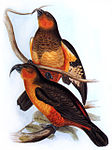

| Nestor | |
|---|---|

| |
| New Zealand kaka (Nestor meridionalis) | |
| Scientific classification | |
| Domain: | Eukaryota |
| Kingdom: | Animalia |
| Phylum: | Chordata |
| Class: | Aves |
| Order: | Psittaciformes |
| Family: | Strigopidae |
| Genus: | Nestor Lesson, 1830 |
| Type species | |
| Psittacus nestor[1] Latham, 1790 | |
| Species | |
|
N. notabilis Kea | |
The genus Nestor is one of the two extant genera of the parrot family Strigopidae.[2] Together with the kākāpō, and the extinct parrots in the genus Nelepsittacus, they form the parrot superfamily Strigopoidea. The Nestor's genus contains two extant parrot species from New Zealand and two extinct species from Norfolk Island, Australia and Chatham Island, New Zealand, respectively. All species are large stocky birds with short squarish tails. A defining characteristic of the genus is the tongue, which is tipped with a hair-like fringe.[3] The superficial resemblance of this tongue to that of lorikeets has led some taxonomists to consider the two groups closely related, but DNA evidence shows they are not.[4][5]
All four species in the genus Nestor are thought to stem from a 'proto-kaka', dwelling in the forests of New Zealand 5 million years ago.[4][6] The closest living relative of the genus is the kākāpō (Strigops habroptilus).[4][6][7][8] Together, they form the Strigopoidea, an ancient group that split off from all other Psittaciformes before their radiation.[4][6][8]
In 2012 Leo Joseph and collaborators proposed that the genus Nestor should be placed in its own family, Nestoridae.[9] This proposal has not been adopted in lists of the world birds and instead Nestor is placed with the genus Strigops in the family Strigopidae.[10][11][12][13]
There are two surviving species and at least one well documented extinct species in the genus Nestor. Very little is known about the fourth, the Chatham kākā, which may have been conspecific with another kaka species.
| Nestoridae | |||
|---|---|---|---|
| Common name (binomial name) status |
Image | Description | Range and habitat |
| Kea
(Nestor notabilis) |
 |
48 cm (19 in) long. Mostly olive-green with scarlet underwings and rump. Dark-edged feathers. Dark brown beak, iris, legs, and feet. Male has longer bill.[15] | New Zealand: South Island High-level forests and subalpine scrublands 850–1400 mAMSL.[16] |
| South Island kākā
(Nestor meridionalis meridionalis) |
 |
Similar to the North Island kākā, but slightly smaller, brighter colours, the crown is almost white, and the bill is longer and more arched in males.[18] | New Zealand: South Island Unbroken tracts of Nothofagus and Podocarpus forests 450–850 mAMSL in summer and 0–550 m in winter.[16] |
| North Island kākā
(Nestor meridionalis septentrionalis) |
 |
About 45 cm (18 in) long. Mainly olive-brown with dark feather edges. Crimson underwings, rump, and collar. The cheeks are golden/brown. The crown is greyish.[18] | New Zealand: North Island Unbroken tracts of Nothofagus and Podocarpus forests between 450–850 mAMSL in summer and 0–550 m in winter.[16] |
| Norfolk kākā |
 |
About 38 cm long. Mostly olive-brown upperparts, (reddish-)orange cheeks and throat, straw-coloured breast, thighs, rump and lower abdomen dark orange.[3] | Formerly endemic on Norfolk Island and the adjacent Phillip Island[20] Rocks and trees[3] |
| Chatham kākā
(†Nestor chathamensis) |
 |
Only known from subfossil bones.[21] | Formerly endemic on Chatham Island of New Zealand Forests[21] |

Of the four species, the Norfolk kaka[19][20] and Chatham kaka[21] became extinct in recent history. The last known individual of the Norfolk kaka died in captivity in London sometime after 1851,[22] and only between seven[23] and 20[24] skins survive. The Chatham kaka became extinct in pre-European times, after Polynesians arrived at the island, between 1550 and 1700, and is only known from subfossil bones.[21] The mainland kaka is listed as endangered,[17][18] and the kea is listed as vulnerable.[14][15]
|
Kea, Kākā and kākāpō (family: Strigopidae)
| |||||
|---|---|---|---|---|---|
| Family |
| ||||
| Nestoridae |
| ||||
| Strigopidae |
| ||||
| |||||
|
Genera of parrots and their extinct allies
| |||||||||||||||||||||||||||
|---|---|---|---|---|---|---|---|---|---|---|---|---|---|---|---|---|---|---|---|---|---|---|---|---|---|---|---|
| |||||||||||||||||||||||||||
| |||||||||||||||||||||||||||
| |||||||||||||||||||||||||||
| Nestor |
|
|---|---|
| Authority control databases: National |
|
|---|